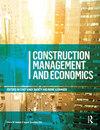民族文化与职业安全——影响丹麦和瑞典建筑工人安全的工人层面因素的比较
IF 3.3
Q2 BUSINESS
引用次数: 0
摘要
摘要丹麦和瑞典在社会和监管方面相似,但职业伤害率差异较大。丹麦的报告受伤率一直是瑞典的两倍,建筑业的致命受伤率高出45%。本研究旨在通过考察合作、感知组织支持、组织公民行为(OCB)、规划、安全动机和长期导向对安全氛围和安全行为的可能影响,进一步调查丹麦和瑞典之间伤害率差异的感知潜在因素。本文基于对来自48个瑞典建筑工地的346名建筑工人和来自37个丹麦建筑工地的465名建筑工作者进行的问卷调查。结果表明,所有六个预测因子都与两国的安全气候和/或安全行为呈正相关。然而,瑞典的预测水平通常更高,与丹麦相比,瑞典与结果的正相关关系更强。具体而言,合作和OCB的估值、规划和长期定位在瑞典更占主导地位。这些差异说明了丹麦和瑞典建筑业受伤率差异的一些可能因素。本文章由计算机程序翻译,如有差异,请以英文原文为准。
National culture and occupational safety – a comparison of worker-level factors impacting safety for Danish and Swedish construction workers
Abstract Denmark and Sweden are societally and regulatory similar countries with large differences in occupational injury rates. Denmark has consistently had twice the rate of reported injuries compared to Sweden and a 45% higher rate of fatal injuries in the construction industry. The current study aims to further investigate the perceived underlying factors responsible for the difference in injury rate between Denmark and Sweden by examining the possible impact on safety climate and safety behaviour of cooperation, perceived organizational support, organizational citizenship behaviour (OCB), planning, safety motivation, and long-term orientation. The paper is based on a questionnaire study completed by 346 construction workers from 48 Swedish construction sites and 465 construction workers from 37 Danish construction sites. The results show that all six predictors were positively related with safety climate and/or safety behaviour in both countries. However, the level of the predictors was generally higher in Sweden, and there was a stronger positive relationship with the outcomes in Sweden than Denmark. Specifically, the valuation of cooperation and OCB, planning and long-term orientation were more dominant in Sweden. These differences illuminate some of the possible factors underlying the difference in injury rate between the Danish and Swedish construction industry.
求助全文
通过发布文献求助,成功后即可免费获取论文全文。
去求助
来源期刊

Construction Management and Economics
BUSINESS-
CiteScore
7.50
自引率
14.70%
发文量
58
期刊介绍:
Construction Management and Economics publishes high-quality original research concerning the management and economics of activity in the construction industry. Our concern is the production of the built environment. We seek to extend the concept of construction beyond on-site production to include a wide range of value-adding activities and involving coalitions of multiple actors, including clients and users, that evolve over time. We embrace the entire range of construction services provided by the architecture/engineering/construction sector, including design, procurement and through-life management. We welcome papers that demonstrate how the range of diverse academic and professional disciplines enable robust and novel theoretical, methodological and/or empirical insights into the world of construction. Ultimately, our aim is to inform and advance academic debates in the various disciplines that converge on the construction sector as a topic of research. While we expect papers to have strong theoretical positioning, we also seek contributions that offer critical, reflexive accounts on practice. Construction Management & Economics now publishes the following article types: -Research Papers -Notes - offering a comment on a previously published paper or report a new idea, empirical finding or approach. -Book Reviews -Letters - terse, scholarly comments on any aspect of interest to our readership. Commentaries -Obituaries - welcome in relation to significant figures in our field.
 求助内容:
求助内容: 应助结果提醒方式:
应助结果提醒方式:


